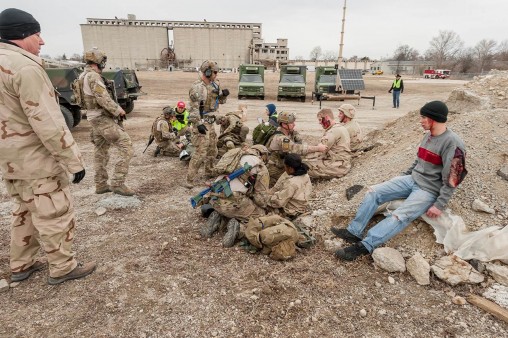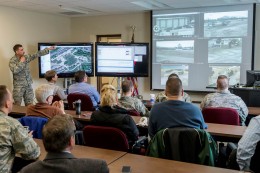
A weeklong training session at Calamityville included an exercise in which pararescue jumpers from the Kentucky Air National Guard rescued injured people.
New technology that promises to revolutionize training in the medical field by combining training with virtual reality was demonstrated at Wright State’s National Center for Medical Readiness (NCMR) at Calamityville.
“This marks the beginning of a unique collaboration between academic centers, industry, Wright-Patterson Air Force Base and NCMR”, said Pamela J. Boyers, Ph.D., executive director of the Interprofessional Immersive Simulation Center at the University of Toledo. “Working together in this manner gives Ohio the opportunity to lead the field in improving the outcomes of medical care.”
The demonstration took place March 27 during a weeklong training session dubbed “Fortis Angel” that included pararescue jumpers from the Kentucky Air National Guard.
The exercise scenario involved rescuing and treating 13 patients injured in a roadside-bomb attack on a caravan of Drug Enforcement Agency agents in South America. There were amputations, collapsed lungs and other simulated injuries.

Instructors watch a live training session in a command center at Calamityville in an effort to improve future training techniques.
Boyers said simulation technicians and emergency department physicians from the University of Toledo took part in the exercise, helping evaluate performance. She said it all translates into improving medical care.
“We are really, really pushing the limits of technology,” she said. “It’s very exciting.”
The training exercise was the culmination of a collaborative effort by the Wright State Research Institute, the National Center for Medical Readiness, Wright-Patterson Air Force Base, the University of Toledo, Cubic Defense Applications, Aptima, CAE Healthcare, Lumir Research Institute, Real Time Immersive Inc., Ball Aerospace & Technologies Corp. and the Black River Systems Company.
This team is creating the next generation of medical education and training technologies and techniques for physicians, nurses, first responders, military personnel and others in the medical domain.
Kristen Barrera, program manager in the warfighter readiness research division of the 711th Human Performance Wing at Wright-Patterson, said the technology can be used in operations or training to create a performance archive that will increase the readiness of responders.
“Over the past several years, we’ve brought that capability here to NCMR,” she said. “Today is really the culmination.”
During the exercise, cameras and microphones captured the action. The pararescuers wore bioharnesses that monitored their vital signs, including heart and respiratory rates. All of the information and simulation rivered into a command center, where it was beamed to instructors from a wall of monitors and computer screens.
John Jannazo, senior director at Cubic, said the technology expands the ability to bring all of the players and subject-matter expertise into a scenario.
“What we’ve built here is a stadium, a playing venue,” Jannazo said. “And whatever is not there in real time will be there virtually. So we’re taking it even beyond the batting averages or how many field goals were made. Now we’re adding coaching right into the event.”
Jim Gruenberg, deputy director of the National Center for Medical Readiness, said the center is providing the landscape, the expertise and the high-fidelity realism that enables researchers, testers and corporations to do important work for the nation.
“This really illustrates how such a place as this can be a real magnet in this community, to bring people to Wright State University, bring people to the region,” he said.
Those involved in the exercise included:
- Air Force Research Laboratory at Wright-Patterson Air Force Base, the backbone for the leading research, contributes technology infrastructure, training expertise and the scenario to support the development of training techniques and methodologies to maintain America’s competitive edge in military operations.
- Aptima and Lumir Research provide training techniques and leading research to expand the evaluation of medical education.
- Ball Aerospace & Technologies Corp., a technology development company, supports the creation of technical components integrated into the Live, Virtual and Constructive (LVC) architecture.
- Black River Systems and Real Time Immersive provides leading virtual and constructive environments that were integrated into the live training at Calamityville.
- CAE Healthcare, a leader in medical simulation technology, provided medical mannequins and further developed the technology to connect remotely to the backbone of the exercise.
- Cubic Defense Applications is a leading technology provider and systems integrator in LVC technologies. It brings an array of products and experience in creating the best-in-class immersive environments for training and education.
- National Center for Medical Readiness provides experts in austere medical training and simulation supporting disaster and emergency response. It also offered the live environment for the exercise.
- University of Toledo provides expertise in medical simulation for the training exercises. Preparation is also underway to create connectivity through virtual integration between NCMR and the newly constructed Interprofessional Immersive Simulation Center at the University of Toledo. Opening in April, this 65,000-square-foot medical modeling and simulation facility provides a wide range of virtual immersive health care settings and technology. A goal for UT is to improve the outcomes of care through advancing training for health care providers.
The National Center for Medical Readiness at Calamityville is a 52-acre disaster training zone with concrete passageway-filled buildings, silos, tunnels, ponds, cliffs and wooded areas. It prepares the civilian and military medical communities to work with traditional disaster responders and provides the nation with a more complete approach to finding patients, offering initial care and safely evacuating them from disaster-related environments.

 Milling around
Milling around  Wright State recognizes Nursing Professor Kim Ringo for advancing international student success
Wright State recognizes Nursing Professor Kim Ringo for advancing international student success  Wright State honors graduating students for distinguished doctoral dissertations
Wright State honors graduating students for distinguished doctoral dissertations  Top 10 Newsroom videos of 2025
Top 10 Newsroom videos of 2025  Museum-quality replica of historic Hawthorn Hill donated to Wright State
Museum-quality replica of historic Hawthorn Hill donated to Wright State 